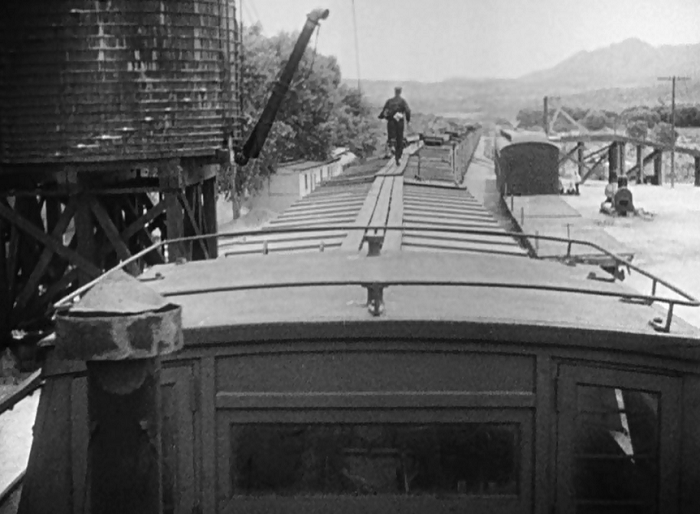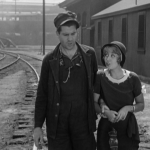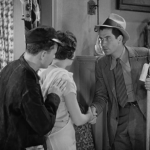Proof That It’s Pre-Code
- Adultery. Duh.
- Our characters get sloshed in a speakeasy, with Joan Blondell busting out some fantastic drunk acting.
- A noble act of suicide saves the day. It should be noted that it does not look painless, though.
- Line that wouldn’t mean the same thing nowadays:
“I’m liable to pull another boner!”
The Particulars of the Picture
 |
 |
 |
| Bill White … Grant Withers |
Jack Kulper … Regis Toomey |
Lily Kulper … Mary Astor |
 |
 |
 |
| Marie … Joan Blondell |
Ed Bailey … James Cagney |
Directed by William A. Wellman |
Other Men’s Women: Finding Love in The Wrong Place
There’s a reason why William Wellman is so intrinsically connected to Pre-Code Hollywood; he’s one of the era’s defining auteurs, a man who took bold risks in the studio system and made movies dozens of movies in that time that all remain, if not great, at least interesting to watch.
Other Men’s Women falls into that category, as Wellman has made a movie well before the technology to make it had totally come into play. It’s a movie that takes place mostly outdoors, full of beautiful tracking shots, and some spectacular stunts and effects work. It’s pretty much everything that most people don’t associate with early talkies– lively and energetic– and that might help to explain why the sound is so crappy throughout the film.

Technical limitations aside, there’s something else interesting about Other Men’s aesthetic, and that is that it spiritually has more in common with French art films of the late 1930’s than most of its studio contemporaries.The freedom of camera movement is matched by a cast of broken characters whose crisscrossing emotions of pain seem right out of Michale Carne’s Port of Shadows or Jean Renoir’s early filmography.
That texture, and some truly beautiful cinematography, definitely make this movie worth viewing, even if, at times, it feels like Wellman is redoing Wings though without trains instead of planes.
Other Men’s Women is about how a simple betrayal can destroy a life. There’s Bill, a drunk and goof who drives trains for the railroad. His best friend and coworker, Jack, is the smart and responsible one, aiming to make it to the front office someday. Jack sees that Bill needs help, so he invites him to stay at his house. Unfortunately, Bill had never met Jack’s wife, Lily, before, and it’s love at first sight.

The arrangement lasts quite a bit before Bill and Lily kiss in a moment of uninhibited delight, they kiss. Lily, a traditional good girl, can’t stand it, and Bill can’t either. A few days later when Jack and Bill are on a run, Jack figures out why the two have been so quiet and distant the last few days and the ensuing fistfight results in a spectacular crash and Jack’s blindness.
Things escalate, as Lily is sent away, Bill is guilt ridden, and then a flood threatens the town. Both Jack and Bill vie for the chance to run a locomotive over a dangerous bridge, and it may just come down to a fistfight to determine who gets the noble sacrifice and a halfway happy ending.
What may speak to the film’s flaws is that the supporting characters are more dynamic than the love triangle. Joan Blondell is on the sidelines as Marie, playing Bill’s dinner waitress girlfriend who resists the catcalls of the other engineers (“I’m APO. Ain’t Puttin’ Out!”) and dotes on Bill despite his lukewarm treatment. Later, after the kiss between Lily and Bill but before Jack figures it out, he halfheartedly proposes to her, and she leaps upon it. They get absolutely hammered, and, I swear to god, you can see the heartbreak in Blondell’s eyes. It is an unbelievably heartbreaking performance for what is a minor role in the melodrama.

The other supporting actor who deserves mention is James Cagney, again at an early section of his career before Wellman elevated him to super stardom with The Public Enemy in both’s next picture. Here he’s Bill’s old friend, who tries to comfort him and stop him from doing anything stupid; it doesn’t work out too well, but Cagney is full of charm as a kid who definitely thrives on the ‘Carpe Diem’ school of thought.
As for the main triangle, it’s well acted, though nothing spectacular. Astor’s blandness doesn’t up the proceedings, though Wellman gives her enough to do that it almost compensates.
The real star of the picture is the direction, and Other Men’s Women looks fantastic. Besides the long shots on top of trains, there’s also a lengthy scene near the end of the film with a blinded Jack trying to make his way through the train pens. The cinematography on this torrential downpour is breathtaking and really drives home the film’s feelings of melancholy.

Other Men’s Women may not be one of the best films from the time, but as an example of the peak of a lively, fascinating director, it can deliver some riches.
Screenshot Gallery
Some shots I took from the film; I really had to limit myself this go around. Click for big!










Trivia & Links
- A more in-depth discussion of this movie is available in 2nd issue of The Pre-Code Companion. You can also see other available issues and topics covered in the series by clicking here or on the banner below.
- Fernando Croce calls this one a proto-Renoir flick, and considering the film’s look and mood, it’s hard to disagree. The film is an expressionistic joy to look at.
- Sheila O’Malley at her self titled blog goes into this film with a sense of awe, and also uses the opportunity to discuss the relationship between Cagney and Blondell.
- The opening and closing credits have no score, and neither does a majority of the film (full film scores were pretty rare in the Pre-Code era regardless). This really adds to the movie in small ways, removing a standard layer of artifice.
- As found via the Three Movie Buffs blog, I really dig the poster for this film:

Availability
- This film is available in Forbidden Hollywood, Volume 3. You can buy that collection from Amazon, and the movie can be rented from Classicflix.






5 Comments
shadowsandsatin · November 24, 2012 at 12:09 am
I share many of your feelings about this film — I wouldn’t necessarily say it was good, but it was fascinating nonetheless. Enjoyed your insights!
Danny · November 24, 2012 at 10:43 am
Yeah. It never connected with me, but there’s so much going on it’s hard not to be impressed. Thanks for commenting!
Judy · November 24, 2012 at 4:40 am
Delighted to discover your blog, Danny – as a fellow pre-Code fan, I hope to visit and comment often! I’m a keen admirer of Wellman (I’ve been reviewing a lot of his work at my blog over the last few years) and pleased to see you describe him as an auteur – he does seem to be getting a lot more recognition now since the issue of the Forbidden Hollywood set devoted to his work and a number of his films have also been issued on Warner Archive, though none of these are available in the UK, where I live, except on import.
I must say I love this film and think Grant Withers is excellent in it, while the all-too brief scenes for Cagney also give a great impression of his screen personality and all that was to come, as with Gary Cooper’s brief appearance in ‘Wings’. Fascinated by the comparison with the French films of the 1930s, which I hadn’t thought of but think is spot on – this has the working-class graininess of the Gabin films from around this period. I’m surprised to see your comments on Blondell’s character, Marie, being really in love with Bill, since I remembered her as being a rather unsympathetic character (though a fantastic performance by Blondell) who wanted to drag Bill down and actually encouraged his desperate drink problem. Sounds as if I missed something here and should look at Marie again when I revisit this movie.
Danny · November 24, 2012 at 11:42 pm
I think Marie had her own problems for sure. I don’t think she discouraged Bill’s drinking, and was ‘bad’ for him but not in a consciously nasty way. She wanted him to love her, and to be loved, and I think that his waffling on his relationship to her was a bigger problem than anything she pushed or pulled him to. Bill tried to be the fun guy who could drink and have fun, but he was obviously overcompensating for being miserable and being generally unhappy with just how crap his life had turned out compared to his friend. At least that’s what I took from it.
Thanks for reading. I’m enjoying your blog so far, and I look forward to seeing more!
ladylavinia1932 · June 10, 2015 at 6:25 am
I didn’t have a problem with the leads. In fact, I thought they were just as good as Cagney and Blondell. I guess since they (along with Mary Astor) became famous, it’s only natural that the other players wouldn’t be regarded that highly.
Comments are closed.